Page is loading ...

Specifications
Wingspan: ............. 71.5 in (1816mm)
Length: ................... 54 in (1371mm)
Wing Area: ............ 965.2 sq in (66.27 sq dm)
ASSEMBLY MANUAL
Alpha .60 ARF
WE GET PEOPLE FLYING
TM
®
Weight: .................. 7.0–8.0 lb (3.2 kg–3.6 kg)
Engine: .................... .61 2-stroke
Radio: ..................... 4-channel w/4 servos

Table of Contents
Covering Colors
2
Covering Colors .......................................................................................................................................................... 2
Contents of Kit ............................................................................................................................................................ 3
Required Radio and Engine ......................................................................................................................................... 3
Field Equipment Required ........................................................................................................................................... 4
Optional Field Equipment ............................................................................................................................................ 4
Additional Required Tools and Adhesives ................................................................................................................... 4
Warning ...................................................................................................................................................................... 4
Before Starting Assembly ............................................................................................................................................ 5
Using the Manual ........................................................................................................................................................ 5
Warranty Information ................................................................................................................................................... 5
Section 1: Joining the Wing Halves ............................................................................................................................ 6
Section 2: Gluing the Panels Together (Optional) ........................................................................................................ 7
Section 3: Fuel Tank Assembly .................................................................................................................................... 8
Section 4: Fuel Tank Installation ................................................................................................................................ 10
Section 5: Radio Installation ..................................................................................................................................... 11
Section 6: Tail Installation ......................................................................................................................................... 15
Section 7: Tail Installation (Glue Attachment Option) ................................................................................................ 17
Section 8: Landing Gear Installation ......................................................................................................................... 21
Section 9: Engine Installation .................................................................................................................................... 24
Section 10: Control Linkage Installation ................................................................................................................... 26
Section 11: Wing Installation (Rubber Band Option) ................................................................................................. 35
Section 11: Wing Installation (Bolt-On Option) ......................................................................................................... 36
Section 12: Control Throws ...................................................................................................................................... 37
Section 13: Center of Gravity .................................................................................................................................... 39
Section 14: Range Testing the Radio ......................................................................................................................... 40
Section 15: Adjusting the Engine .............................................................................................................................. 40
Section 16: Preflight ................................................................................................................................................. 40
Glossary of Terms ..................................................................................................................................................... 41
2004 Official AMANational Model Aircraft Safety Code ............................................................................................. 42
• True Red HANU866
• Deep Blue HANU873
• White HANU870
• Silver HANU881

Contents of Kit
Required Radio and Engine
3
Large Parts:
A. Wing Set w/Alum. Tube HAN2601
B. Fuselage HAN2602
C. Tail Set HAN2603
D. Landing Gear Set HAN2604
E. Wing Tube HAN2605
F. 23/4" Wheels HAN305
G. 3" Wheels HAN306
Radio Equipment
• 4-channel radio system (minimum)
• 4 standard servos (JRPS537 recommended
or equivalent)
• 6" Servo Extension (JRPA095)
Recommended JR® Systems
• Quattro
• XF421EX
• XF631
• XP662
• X-378
• XP6102
Recommended Engine
• .61 2-stroke
Items Not Shown:
Engine Mount HAM90M
Pushrod Set HAN2607
Fuel Tank (assembled) HAN2606
Note: Wheels are shown installed.
JR XF631
Evolution .61NT
EVOE0610
C
JR XF421EX
A
B
D
G
E
F

Warning
Additional Required Tools and Adhesives
Field Equipment Required
Optional Field Equipment
4
Tools
• Adjustable wrench
• Drill
• Drill bit: 5/64", 3/32”
• Hobby Knife (XAC3126)
• Phillips screwdriver (small)
Adhesives
• 30-Minute Epoxy (HAN8002)
• Thick CA (cyanoacrylate) Glue (PAAPT02)
• CA Remover/Debonder (PAAPT16)
• Masking Tape (MMM20901)
Other Required Items
• 21/2" spinner (white) (EVOE0610S recommended)
• Epoxy Brushes (DUB345)
• Felt-Tipped Pen (PAR10400)
• File
• Measuring device (e.g. ruler, tape measure)
• Mixing Sticks for Epoxy (DUB346)
• Paper towels
• Rubbing alcohol
• Wax paper
An RC aircraft is not a toy! If misused, it can cause serious bodily harm and damage to property. Fly only in open
areas, preferably at AMA (Academy of Model Aeronautics) approved flying sites, following all instructions included
with your radio and engine.
• Propeller (EVOE0610P recommended)
• Fuel (10%–15% nitro content)
• Glow Plug Wrench (HAN2510)
• Glow Plug Igniter with Charger (HAN7101)
• Glow Plug (HAN3001/3006)
• Manual Fuel Pump (HAN118)
• #64 Rubber Bands (ARC64)
• Start-Up Field Pack (HANSTART)
• 4-Way Wrench (DUB701)
• Fieldmate (HAN117)
• Cleaner & towels
• Extra Glow Plugs (HAN3001/3006)
• Blue Block After Run Oil (EVOX1000)
• Power Panel (HAN106)
• 12V 7Ah Sealed Battery (HAN102)
• PowerPro 12V Starter (HAN161)

Before Starting Assembly
Using the Manual
Warranty Information
5
Before beginning the assembly of the Alpha™, remove each part from its bag for inspection. Closely inspect the
fuselage, wing panels, rudder, and stabilizer for damage. If you find any damaged or missing parts, contact the
place of purchase.
If you find any wrinkles in the covering, use a heat gun or covering iron to remove them. Use caution while
working around areas where the colors overlap to prevent separating the colors.
This manual is divided into sections to help make assembly easier to understand and to provide breaks between
each major section. In addition, check boxes have been placed next to each step to keep track of each step
completed. Steps with multiple boxes indicate the step will require repeating, such as for a right or left wing
panel, two servos, etc. Remember to take your time and follow the directions.
Horizon Hobby, Inc. guarantees this kit to be free from defects in both material and workmanship at the date of
purchase. This warranty does not cover any parts damage by use or modification. In no case shall Horizon Hobby's
liability exceed the original cost of the purchased kit. Further, Horizon Hobby reserves the right to change or modify
this warranty without notice.
In that Horizon Hobby has no control over the final assembly or material used for the final assembly, no liability
shall be assumed nor accepted for any damage of the final user-assembled product. By the act of using the product,
the user accepts all resulting liability.
Once assembly of the model has been started, you must contact Horizon Hobby, Inc. directly regarding any warranty
question that you have. Please do not contact your local hobby shop regarding warranty issues, even if that is where
you purchased it. This will enable Horizon to better answer your questions and service you in the event that you may
need any assistance.
If the buyer is not prepared to accept the liability associated with the use of this product, the buyer is advised to
return this kit immediately in new and unused condition to the place of purchase.
Horizon Hobby
4105 Fieldstone Road
Champaign, Illinois 61822
(877) 504-0233
www.horizonhobby.com

Section 1: Joining the Wing Halves
6
Required Parts
• Right wing panels • Left wing panel
• Wing joiner tube
Required Tools and Adhesives
• Hobby knife
Skip to Section 2 if you plan on joining
the wings together permanently.
Step 1
Locate the wing joiner tube. Slide the tube into one
of the wing panels.
Step 2
Slide the remaining wing panel onto the tube tightly
against the first panel.
Step 3
Apply the clear tape to the joint, starting at the front
of the servo tray. Wrap the tape around the leading
edge, then onto the top of the wing. Continue around
the trailing edge of the wing, back to the servo tray.
Trim the excess tape using a hobby knife.

Section 2: Gluing the Panels Together (Optional)
7
Required Parts
• Right wing panels • Left wing panel
• Wing joiner tube
Required Tools and Adhesives
• Masking tape • 30-minute epoxy
• Epoxy brush • Mixing stick
• Rubbing alcohol • Paper towels
• Hobby knife
The two wing panels can be glued together if
you choose to do so. Read through the steps
and wait to mix the epoxy until the steps are
fully understood.
Step 1
Locate the wing joiner tube. Slide the tube into one
of the wing panels.
Step 2
Mix 1/2 ounce of 30-minute epoxy. Apply the
epoxy to the exposed wood at the root rib.
Step 3
Slide the remaining wing panel onto the tube tightly
against the first panel. Use masking tape on the top
and bottom of the wing to hold the panels tightly
together until the epoxy cures.
Hint: Use a paper towel moistened with
rubbing alcohol to clean up any epoxy before
it has a chance to cure.

Section 3: Fuel Tank Assembly
8
Required Parts
• Clunk (fuel pickup) • Metal caps (2)
• Fuel pickup tubing • Fuel tank
• Rubber stopper • 3mm x 20mm screw
• Metal tubes (short and long)
Required Tools and Adhesives
• Phillips screwdriver (small) • Hobby knife
The stopper provided with your model has
three holes that are not bored completely
through the stopper. The holes are for the
fuel pickup, fill, and vent lines. For these
instructions only, two holes will be used:
one for the fuel pickup and one for the fuel
vent. Only open the third hole if you are
going to use a separate fill line.
Step 1
Locate the fuel tank parts.
Step 2
Locate the rubber stopper. Insert the short metal
tube into one of the holes in the stopper so that an
equal amount of tube extends from each side of the
stopper. This tube will be the fuel tank pickup that
provides fuel to the engine.
Step 3
Slide the smaller cap over the tube on the smaller
end of the rubber stopper. This end will be inserted
into the fuel tank. The larger cap is placed on the
side of the rubber stopper that makes the cap.
Loosely install the 3mm x 20mm screw through
the center of the stopper.

Section 3: Fuel Tank Assembly
9
Step 4
Locate the vent tube. It is the one that has a slight
bend. Slide the longer end of the vent tube into the
remaining hole in the stopper from the tank (small
cap) side. The bend must be on the back of the
stopper, so it ends up inside the fuel tank.
Step 5
Locate the clear piece of silicone fuel tubing and
the fuel tank clunk. Install the clunk onto one end
of the silicone tubing. Slide the silicone tubing (end
opposite the clunk) onto the fuel tank pickup tube
(straight tube) in the stopper.
Step 6
Carefully insert the stopper assembly into the fuel
tank. Note the position of the vent tube; it must point
towards the top of the fuel tank to function properly.
(The stopper is located towards the top of the tank.)
Check to make sure the clunk can move
freely inside the tank. You must be able
to turn the tank to any attitude, and the
clunk will fall to the lowest point (all
directions except for having the stopper
facing down). If it does not, remove the
stopper and shorten the line by 1/16 inch
and check again. Take your time during
this step, as it is important that the clunk
operates properly. Having the line too short
will keep the engine from drawing all the
fuel from the tank.

Section 3: Fuel Tank Assembly
Section 4: Fuel Tank Installation
10
Step 7
Tighten the 3mm x 20mm screw carefully—do not
overtighten, as this can cause the the fuel tank to
split open. This allows the rubber stopper to form
a seal by being slightly compressed, thus sealing
the fuel tank opening.
Step 8
Install the vent and pickup tubes. Use the red tube
on the vent, and the green tube on the pickup. This
will be helpful later when installing the lines to
the engine.
Required Parts
• Fuselage • Fuel tank assembly
Required Tools and Adhesives
• None
Step 1
Slide the fuel tank into the fuselage. Make sure the
stopper faces the top of the fuselage.
Step 2
Guide the fuel lines through the large hole in the
firewall. Push the fuel tank as far forward as possible.

Section 5: Radio Installation
11
Required Parts
• Fuselage • Foam radio protector
• Radio tray (plywood)
• #6 x 5/8" sheet metal screw
Required Tools and Adhesives
• Standard servo (4) • Servo hardware
• Receiver • Radio battery pack
• Switch harness • 6" servo extension
• Phillips screwdriver (small) • Drill bit: 5/64"
• Drill
Step 1
Install the rubber grommets and eyelets supplied with
your servos. Use the instructions provided with the
radio system for this procedure.
Step 2
Test fit a servo into one of the openings in the
fuselage. Use a small sander to make the opening
bigger if the servo does not fit. Check and fit
all three servos.

Section 5: Radio Installation
12
Step 3
Position the three servos as shown. Use the screws
provided with the servos to secure them in position.
Step 4
Cut one of the flat foam pieces to a length of 51/2".
Place the foam piece inside the fuselage as shown.
Step 5
Plug the servos, receiver and aileron extension into
the receiver. Use the radio instructions to make sure
the servos are plugged into the correct channels. Use
the photo in Step 3 that labels the elevator, rudder
and throttle servos.
Step 6
Cut pieces of the remaining foam to fit at the front
and rear of the radio area. Place the receiver and
receiver battery onto the foam as shown. Position
the servo wires so they are neat and not cluttering
the area around the receiver and receiver battery.
Use the remaining foam to insulate the receiver and
receiver battery from the sides of the fuselage and
from each other.

Section 5: Radio Installation
13
Step 7
Route the receiver antenna wire through the antenna
tube located on the right side of the fuselage. This
routes the antenna to the rear of the fuselage.
Step 8
Check to make sure the aileron servo lead and
receiver antenna wire are accessible. Place the
remaining flat radio foam piece over the receiver
battery and receiver.
DO NOT cut the antenna wire, as this will
significantly reduce the range and operation
of your radio system.
To make the installation of the receiver
antenna easier, use a small piece of music
wire. Slide the wire into the antenna tube
from the back of the fuselage. Attach the
receiver antenna to the wire and pull it
through the tube.
Step 9
Slide the plywood radio tray into the notches in the
former. Push the tray forward, against the fuel tank.

Section 5: Radio Installation
14
Step 10
Drill a 5/64" hole in the tray support using the hole in
the aft end of the tray as a guide.
Step 11
Secure the tray using a #6 x 5/8" sheet metal screw.
Step 13
Remove the switch plate from the radio switch.
Attach the switch to the fuselage side using the
switch hardware.

Section 6: Tail Installation
15
Required Parts
• Fuselage • Rudder/fin
• Stabilizer/elevator
Required Tools and Adhesives
• Wing nut (2) • #4 washer (4)
• 4-40 x 3/4" screw (2) • Threadlock (included)
• Phillips screwdriver
Skip to Section 7 if you plan on joining
the tail to the fuselage permanently.
Step 1
Slide the fin bolts into the holes in the stabilizer.
Make sure the trim is facing towards the fin.
Push the fin tight against the stabilizer.
Step 2
Apply a small drop of threadlock onto each of
the fin bolts.
Step 3
Slide a 3mm washer onto the fin bolts. Thread
the wing nuts onto the bolts. Tighten the nuts
against the stabilizer. Do not crush the wood
when tightening the nuts.
Step 4
Place the stabilizer in position on the fuselage.
The fin will fit into the slot in the fuselage when
installed correctly.

Section 7: Tail Installation (Glue Attachment Option)
17
Required Parts
• Fuselage • Rudder/fin
• Stabilizer/elevator
Required Tools and Adhesives
• Wing nut (2) • 30-minute epoxy
• 4-40 x 3/4" screw (2) • #4 washer (4)
• Phillips screwdriver • Felt-tipped pen
• Threadlock
The tail can be glued together, then glued
to the fuselage if you choose to do so. Read
through the steps and wait to mix the epoxy
until the steps are fully understood.
Step 1
Slide the fin bolts into the holes in the stabilizer.
Make sure the trim is facing towards the fin. Push the
fin tight against the stabilizer.
Step 2
Use a felt-tipped pen to trace the outline of the fit
onto the stabilizer.
Step 3
Use a hobby knife with a new blade to remove the
covering inside the lines drawn in the last step. Also
remove the covering from the bottom of the fin where
it rests against the stabilizer.
DO NOT cut into the underlying wood. Let
the knife “float” across the covering. Cutting
into the wood will weaken the stabilizer and
may cause it to fail in flight.
You can use a soldering iron instead of a
hobby knife to remove the covering. Doing
so will eliminate accidentally cutting into
the stabilizer.

Section 7: Tail Installation (Glue Attachment Option)
18
Note: Read through and understand Steps 4
through 7 before mixing any epoxy.
Step 4
Mix a small amount of 30-minute epoxy and apply
it to the exposed wood on the stabilizer.
Step 5
Re-install the fin onto the stabilizer.
Step 6
Apply a small drop of threadlock onto each of
the fin bolts.
Step 7
Slide a 3mm washer onto the fin bolts. Thread
the wing nuts onto the bolts. Tighten the nuts
against the stabilizer. Do not crush the wood when
tightening the nuts.
Step 8
Place the stabilizer in position on the fuselage.
The fin will fit into the slot in the fuselage when
installed correctly.

Section 7: Tail Installation (Glue Attachment Option)
19
Step 9
Trace the outline of the fuselage onto the bottom of
the stabilizer using a felt-tipped pen.
Step 10
Remove the covering from the bottom of the stabilizer
using a hobby knife or soldering iron.
Note: Remove the covering from the rear of
the stabilizer up to the bolt as shown.
Note: Read through and understand Steps 11
through 14 before mixing any epoxy.
Step 11
Mix 1/2 ounce of 30-minute epoxy. Apply the epoxy
to the exposed wood on the bottom of the stabilizer.
Step 12
Place the stabilizer/fin assembly back onto the
fuselage. Slide a #4 washer onto a 4-40 x 3/4" screw.
Apply a drop of threadlock to the screw. Prepare two
screws using this method.
/










